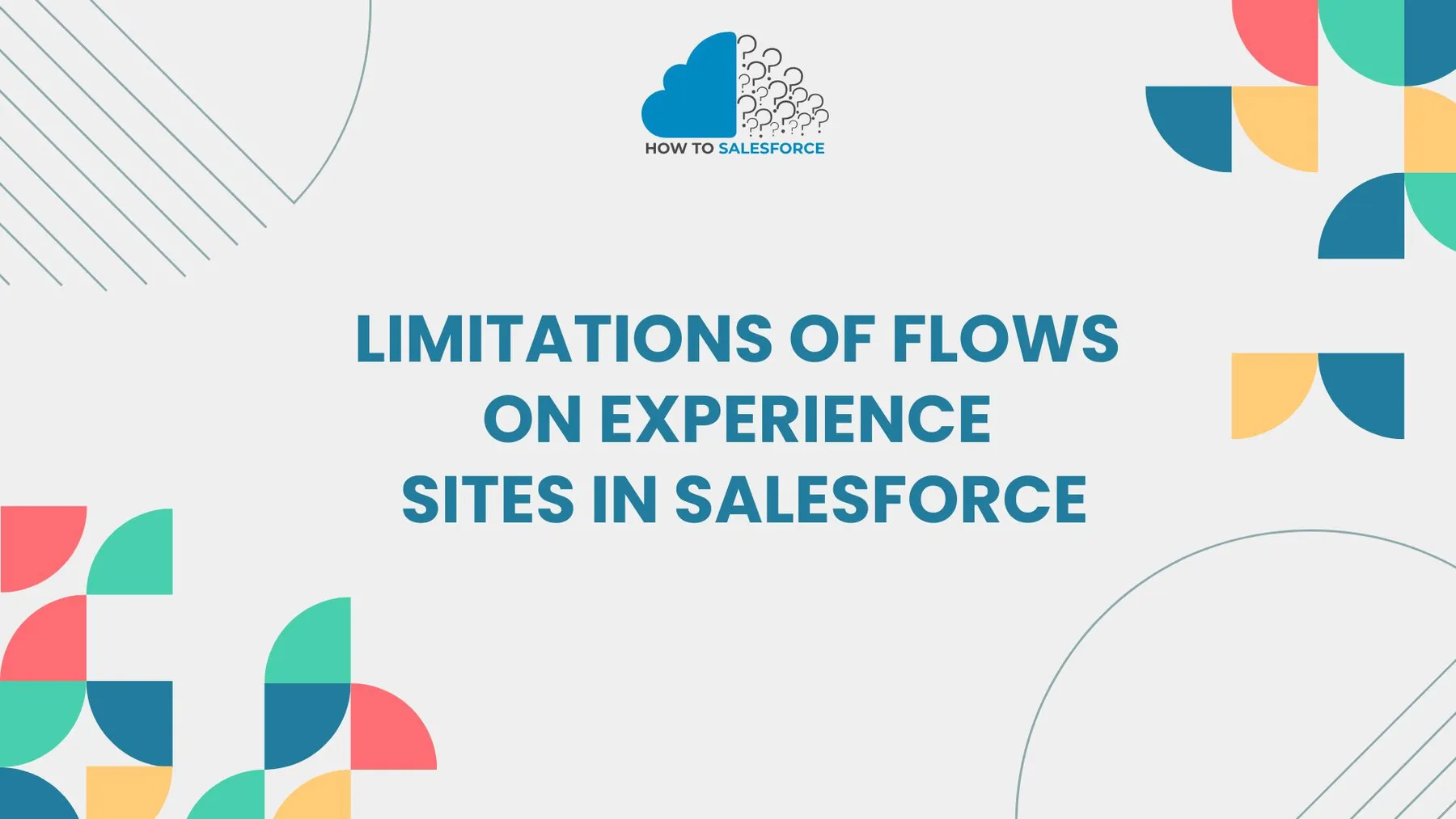Introduction
Experience Sites with Salesforce flows enhance user experience and automate processes. They create responsive, dynamic websites that simplify navigation and consumer interactions. Knowing the major constraints of Salesforce Experience Sites is crucial while developing flows. This post will explain Experience Site Salesforce flows’ limits and how to use them.
Stay informed! Explore more in my latest article: Salesforce Omnichannel Route Parent Cases
What Are Flows in Salesforce Experience Sites
Salesforce flows automate complex processes and simplify Experience Site user data exchanges. Guided flows help visitors locate information, complete tasks, and traverse the website. Flows are versatile yet have security, performance, and data access issues.
Experience Site managers can do the following with flows:
- Automate Processes: Increase user productivity and simplify intricate workflows.
- Offer a Guided Experience: Assist users in completing tasks by providing detailed instructions.
- Customize Interactions: Adapt content according to particular standards, like account type or user roles.
To use flows effectively, it is essential to comprehend these capabilities, particularly when the limitations could affect overall functionality.
Key Limitations of Flows on Salesforce Experience Sites
Although flows offer increased functionality and automation, there are limitations that must be taken into consideration. Let’s look at each of these restrictions in more detail and consider how to overcome or get around them.
Performance Constraints in Large Data Sets
Performance problems may arise when flows need to process or query large data sets. Experience sites with large user bases or databases should pay particular attention to this.
- Impact on User Experience: Slow flows can cause users to experience delays.
- Load Times May Increase: Websites may take longer to load, which could impact usability and navigation.
- For instance: the system may encounter difficulties and respond slowly if a flow is required to process records from a large object with thousands of entries.
Solution: To solve this, avoid querying too many records and, if at all possible, divide complicated tasks into smaller sub-flows. Finding bottlenecks early on can be facilitated by testing flow performance using various data sets.
Limited Record Access
Knowledge of Site flows frequently runs into issues when trying to access records, particularly when working with data that has limited visibility because of security settings, user roles, or permissions. Delivering seamless user experiences or providing personalized content may become difficult as a result.
- Restricted Data Access: Role-based access restrictions may prevent users from viewing essential records.
- Profile-Based Access: Certain flows may only be viewed or interacted with by users who possess the necessary authorization.
- Example: If users do not have the required permissions, they may not be able to access a flow that is intended to display particular cases.
Solution: Give users who need access to specific flows the proper permissions. If security policies allow, think about changing permission sets or making a public record version of certain records if they are necessary.
Constraints on Complex Logic
Complex logic, such as intricate process chains or deeply nested conditional statements, is difficult for flows on Experience Sites to handle. Implementing such intricacy may lead to unpredictable behavior, which could make flows sluggish or unreliable.
- Limitations in Condition Complexity: Errors may arise from intricately nested conditions.
- Decreased Flexibility: Complex logic may be too complex for the system to handle, leading to errors or unresponsive flows.
Solution: Make the flow logic as simple as you can. For more complex functionality, divide complex processes into distinct flows or use different tools, such as Apex classes.
Guest User Authentication Challenges
Because of authentication requirements, guest users frequently encounter restrictions when accessing flows on Experience Sites. This may limit access to specific flow functions or make flows inaccessible to all users.
- Guest User Access Limitations: Guests are not permitted to access certain flows.
- Security Protocol Requirements: For security purposes, Salesforce’s authentication protocols may prevent visitors from accessing specific flows.
- Example: If guest users do not have the required authentication, a flow intended to retrieve user-specific data may fail.
Solution: Whenever feasible, use alternate techniques for visitors. Simplify access requirements for public flows, or think about utilizing alternative authentication techniques that adhere to Salesforce’s security guidelines.
Best Practices for Overcoming Limitations on Experience Sites
Moreover, Follow best practices when utilizing flows on Experience Sites to guarantee peak performance. These procedures reduce performance problems, preserve a smooth user experience, and guarantee that flows satisfy functional and security requirements.
Optimize Flow Performance: Limitations of Flows on Experience Sites in Salesforce
Simplify your processes and maximize each element for optimal performance. Minimize the number of steps in each flow and refrain from using intricate data operations.
- Decrease Flow Steps: To prevent delays, reduce the number of steps.
- Filter Data for Efficiency: Before processing, filter data to lessen the strain on your flow.
- Example: When possible, avoid querying large objects and use filters to pull only the data that is required.
To identify performance bottlenecks and make sure your flows work properly under various loads, test them using various data sets.
Assign Clear Access Permissions
Enable users to interact with flows without encountering access limitations by setting specific access permissions. Permissions should be defined according to user roles and business requirements.
- Use Role-Based Permissions: Give users who require access to specific flow roles.
- Regularly Modify Permission Sets: Modify permissions in response to changes in user roles or requirements.
- For instance: to prevent unwanted access and preserve flow security, give experienced site users only the permissions required for their position.
Correctly implementing permissions keeps all users safe and avoids access problems.
Simplify Logic in Flows: Limitations of Flows on Experience Sites in Salesforce
Whenever feasible, keep logic inflows simply to preserve dependability and functionality.
- Limit Condition Nesting: Maintain the simplest possible conditions.
- Use Alternative Automation Tools: Use Process Builder for sophisticated processes or offload complex logic to Apex classes.
- Example: Manage sophisticated logic outside of flow tools and divide complicated tasks into simpler flows.
In general, simple flows on Experience Sites are quicker, more dependable, and simpler for users to navigate.
Secure Guest User Access with Authentication Settings
For security and accessibility to be maintained, guest user flows must be carefully configured. When appropriate, restrict guest flow interactions and use authentication settings.
- Restrict Guest Access to Sensitive Data: To preserve privacy, restrict the amount of data that visitors can access.
- Set Up Clear Authentication Protocols: Make sure specific flows are only accessible by authorized users.
- Example: Secure private or customized flows while restricting guest user flows to public content or non-sensitive data.
While maintaining usability, carefully arranging access settings improves security for Experience Site visitors.
Common Challenges with Flows on Experience Sites and How to Solve Them
Even with meticulous preparation, there may be some difficulties when utilizing flows on Experience Sites. The most common problems and workable fixes for each will be covered.
Challenge: User Complaints of Slow Response Times
Users may encounter delays that impair navigation and satisfaction when flows run into data bottlenecks.
- Solution: Divide difficult tasks into manageable chunks and streamline the process. To find bottlenecks, test the flow frequently. To reduce the number of records that are retrieved, use data filters rather than intricate logic or deeply nested conditions.
Challenge: Restricted Data Visibility for Certain Users
Users may find it difficult to access important information if they lack the necessary permissions.
- Solution: To provide the required access, update role-based permissions. Modify visibility case-by-case using permission sets to make sure users only see information that is pertinent to their requirements.
Challenge: Security Concerns for Guest User Access
Unintentional access to sensitive flows by guest users could cause security problems.
- Solution: Set up processes to limit access to private data, ensuring that guest users can only see public or non-essential content. To safeguard data while maintaining flow accessibility where required, use alternate authentication techniques.
Challenge: Complex Logic Breaking Flow Functionality
Processing constraints can cause complex logic flows to crash or encounter errors.
- Solution: Whenever feasible, transfer complex procedures to other tools, like Apex classes. To improve functionality and lower the chance of error, divide the load into simpler sub-flows when complex conditions are necessary.
How to Maximize Flow Efficiency on Experience Sites
Furthermore, To maintain the functionality of your flows and improve user satisfaction, remember these efficiency tips. They support seamless operation and enhance Experience Sites’ user experience.
- Regularly Test and Optimize Flows: To identify performance problems, test flows with different data loads.
- Restrict Unnecessary Access to Data: Retrieve only the information required for the flow to carry out its necessary tasks.
- Use Automation Tools in Combination: For more complicated requirements, combine flows with other automation tools such as Apex or Process Builder.
- Keep Flows Simple for User Navigation: To make flows easier for users to navigate, and eliminate superfluous conditions or decision branches.
By using these strategies, you can make sure your flows run smoothly and continue to benefit Experience Site users.
Conclusion
Although flows are crucial tools for Experience Site Salesforce, they have significant drawbacks that should be carefully considered. Comprehending these limitations, which range from performance limitations to restricted access and security concerns, guarantees that your flows are optimized for functionality and efficiency. You can get past these obstacles and offer a productive, user-friendly experience on Salesforce Experience Sites by adhering to best practices, streamlining flow logic, and conducting frequent testing.


